Pain Self-management in Adolescent with Dysmenorrhea
Downloads
Introduction:Complaints that often occur are dysmenorrhea that is not harmful but can interfere with comfort and activity. An adolescent who know the proper management of dysmenorrhea can overcome it and have good pain management. The study aimed to analyze pain self-management in adolescents with dysmenorrhoea.
Methods: This study used correlational research with a cross-sectional approach. The population in thisstudy were adolescent at Public Junior High School IV Lamongan. The samples were 129 respondents selected by simple random sampling. The inclusion criteria were an adolescent who analyzes dysmenorrhea. The exclusion criteria for this study were not in place due to illness or alpha. Data was collected using questionnaire self-efficacy, decision making, information support, and pain self-management that had been tested for validity and reliability”test statistics using the Spearman's rho test.
Results: The results of the study found a correlation between self-efficacy with pain self-management (p = 0.004; r = 0.24), decision making with pain self-management (p = 0.003; r = 0.26), information support with pain self-management (p = 0.003; r = 0.26).
Conclusion: Self-efficacy is a mediator to improve pain self-management optimally to improve qualityof life. There are three factors in decision making for pain management in adolescents who experience dysmenorrhea is personal, social, and psychological. Adolescents who have initiatives in finding information about dysmenorrhea have good pain management. It is expected that parents, schools, and health workers provide knowledge to an adolescent who experiences dysmenorrhea to be able to do pain management.
Alwisol (2009) Psikologi Kepribadian. Malang: UMM Press.
Atak, N (2007) The Effect of Education on Knowledge, Self-management Behaviors and Self Efficacy of Patient with Type 2 Diabetes. Australian Journal of Asvanced Nursing. Vol 2 Number. 2.
Aziato, L., Dedey, F. and Clegg-Lamptey, J. (2014) 'The experience of dysmenorrhoea among Ghanaian senior high and university students: pain characteristics and effects', Reproductive Health.
Chen, C. et al. (2016) 'Beliefs About Dysmenorrhea and Their Relationship to Self-Management'.
Chlebowy, Diane orr et al. (2009) Gender Differences in Diabetes Self-management Among African American Adults DOI. 10.1177/0193945912473370.
Chiu, M. et al. (2017) 'Influencing factors of dysmenorrhoea among hospital nurses : a questionnaire survey in Taiwan'.
G, Kisokanth. (2013) 'Factors Influencing Self-management of Diabetes Mellitus: a Review Article', Sri Lanka : Eastern University & the University of Sri Jayewerdenepura.
Kotler, P. (2018) Prinsip – Prinsip Pemasaran Manajemen. Jakarta: Prenhalindo.
Marlinda, R., Rosalina and Purwaningsih, P. (2013) ‘Pengaruh senam terhadap penurunan dismenore pada remaja putri di desa sidoharjo kecamatan pati', Jurnal Keperawatan Maternitas, 1(2), pp. 118–123.
Midilli, T. S., Yasar, E. and Baysal, E. (2015) 'Dysmenorrhea Characteristics of Female Students of Health School and Affecting Factors and Their Knowledge and Use of Complementary and Alternative Medicine', pp. 194–204.
Nursalam (2015) Metodologi Penelitian Ilmu Keperawatan: Pendekatan Praktis. 4th edn. Edited by P. P. Suslia, A and E. Lestari. Jakarta: Salemba Medika.
Nursalam (2017) Metodologi Penelitian Ilmu Keperawatan. 4th edn. Jakarta: Salemba Medika.
Nurwana, Yusuf, S. and Faizal (2017) ‘Analisis Faktor yang Berhubungandengan Kejadian dismenore pada Remaja Putri di SMA Negeri 8 Kendari year 2016', p. 250–731X.
Pajares, F. (2010) 'Self-efficacy beliefs' DOI. 10.1016/B978-0-08-044894-7.00620-5.
Ryan, P. and Sawin, K. (2009) 'The Individual and Family Self-Management Theory : Background and perspectives on context, process, and outcomes'.
Sari, D. (2015) ‘Hubungan Stres dengan Kejadian Dismenore Primer pada Mahasiswi Pendidikan Dokter Fakultas Kedokteran Universitas Andalas', 4(2).
Sewvandi, H. et al. (2018) Knowledge and attitudes towards dysmenorrhea among adolescent girls in an urban school in Sri Lanka', pp. 58–64.
Suliawati, G. (2013) ‘Hubungan Umur, Paritas Dan Status Gizi Dengan Kejadian Dismenore Pada Wanita Usia Subur Di Gampong Baitussalam Aceh Besar', Skripsi STIKes U'budiyah Banda Aceh.
Wong, C. (2018) 'Health-related quality of life among Chinese adolescent girls with Dysmenorrhoea', pp. 1–10.
Yücel, G., Kendirci, M. and Gül, Ü. (2018) 'Menstrual Characteristics and Related Problems in 9- to 18-Year-Old Turkish School Girls', J Pediatr Adolesc Gynecol, 31(4), pp. 350–5.
Copyright (c) 2020 Cherlys Tin Lutfiandini, Tiyas Kusumaningrum, Ni Ketut Alit Armini

This work is licensed under a Creative Commons Attribution 4.0 International License.
1. The journal allows the author to hold the copyright of the article without restrictions.
2. The journal allows the author(s) to retain publishing rights without restrictions.
3. The legal formal aspect of journal publication accessibility refers to Creative Commons Attribution (CC BY).





















